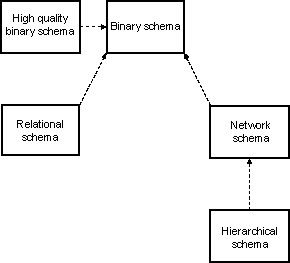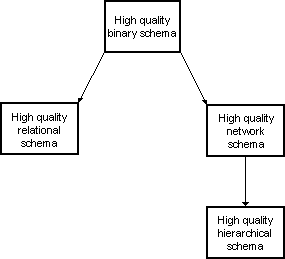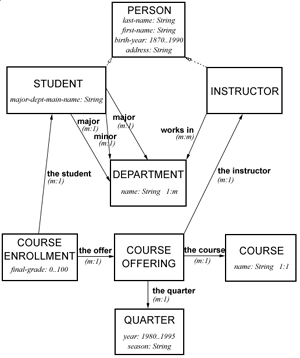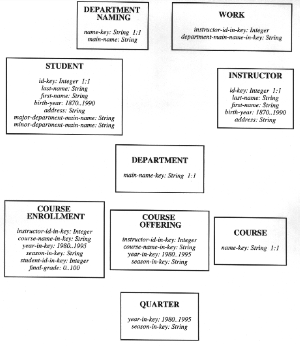Chapter 8
The Progression of Database Models
Four database models have been discussed in this text: Semantic,
Relational, Network, and Hierarchical. This chapter compares aspects
of theses models.
Each of the models provides a certain degree of data independence -
the isolation of the application programmer from representational or
implementational details. The following table illustrates five levels
of data independence.
|
Level
|
Who is transparent to the user?
|
Database model
|
|
V
|
The representation of information by data
|
Semantic Binary
|
|
IV
|
The organization of access to data
|
Relational
|
|
III
|
The physical implementation of the logical data-access structure
|
Network
|
|
II
|
The physical implementation of the special data structure Hierarchy
|
Hierarchical
|
|
I
|
The physical implementation of logical files by bytes on disks
|
File management systems
|
Figure 8-1. Levels of data independence
The Relational, Network, and Hierarchical models were derived from the
Binary Model as its subsets. A schema in any one of those models is a
binary schema satisfying certain criteria. Those criteria are related
to the implementational restrictions of the model. The following
diagram shows the subsets of the Binary Model.

Figure 8-2. The generalization of data models. For
example, the relational schemas form a subcategory of the binary
schemas.
The following figure depicts the schema design methodologies presented
in this text. The goal of the methodologies is to produce high-
quality databases in the Relational, Network, and Hierarchical models.

Figure 8-3. The schema-conversion methodologies
studied in this text.
To review and compare some of the structural characteristics of the
four database models studied in this text, the following series of
examples solves the same query in the Predicate Calculus language,
using, in turn, each of the four database models.
The examples use the four reference schemas of the university
application at the end of this book. The query prints the pairs of the
names of students and instructors, where the instructor works in the
student's major department.
Example 8-1:
- Binary:
- get s.LAST-NAME, i.LAST-NAME
- where i WORKS-IN s.MAJOR-DEPARTMENT
Example 8-2:
- Relational:
- get s.LAST-NAME, i.LAST-NAME
- where
- i is an INSTRUCTOR and
- s is a STUDENT and
- exists w in WORK:
- (w.INSTRUCTOR-ID-in-key = i.ID-key and
- s.MAJOR-DEPARTMENT-MAIN-NAME =
w.DEPARTMENT-MAIN-NAME-in-key)
Example 8-3:
- Network:
- get s.LAST-NAME, i.LAST-NAME
- where
- i is an INSTRUCTOR and
- s is a STUDENT and
- exists w in WORK:
- (i INSTRUCTOR-WORK w and
- exists d in DEPARTMENT:
- (d DEPARTMENT-WORK w and
- d MAJOR-ST s))
Example 8-4:
- Hierarchical:
- get s.LAST-NAME, i.LAST-NAME
- where
- i is an INSTRUCTOR and
- s is a STUDENT and
- exists w in WORK:
- (i.ID = w.INSTRUCTOR-ID and
- exists d in DEPARTMENT:
- (d DEPARTMENT-WORK w and
- d.MAIN-NAME = s.MAJOR-DEPARTMENT-MAIN-NAME))
Reference Schemas
The following are the semantic and relational schemas for the
university case study application. These schemas are referred to in
most of the examples in this text.

Figure Ref-1. A semantic schema for a university
application.

Figure Ref-2. A relational schema for the university
application.




